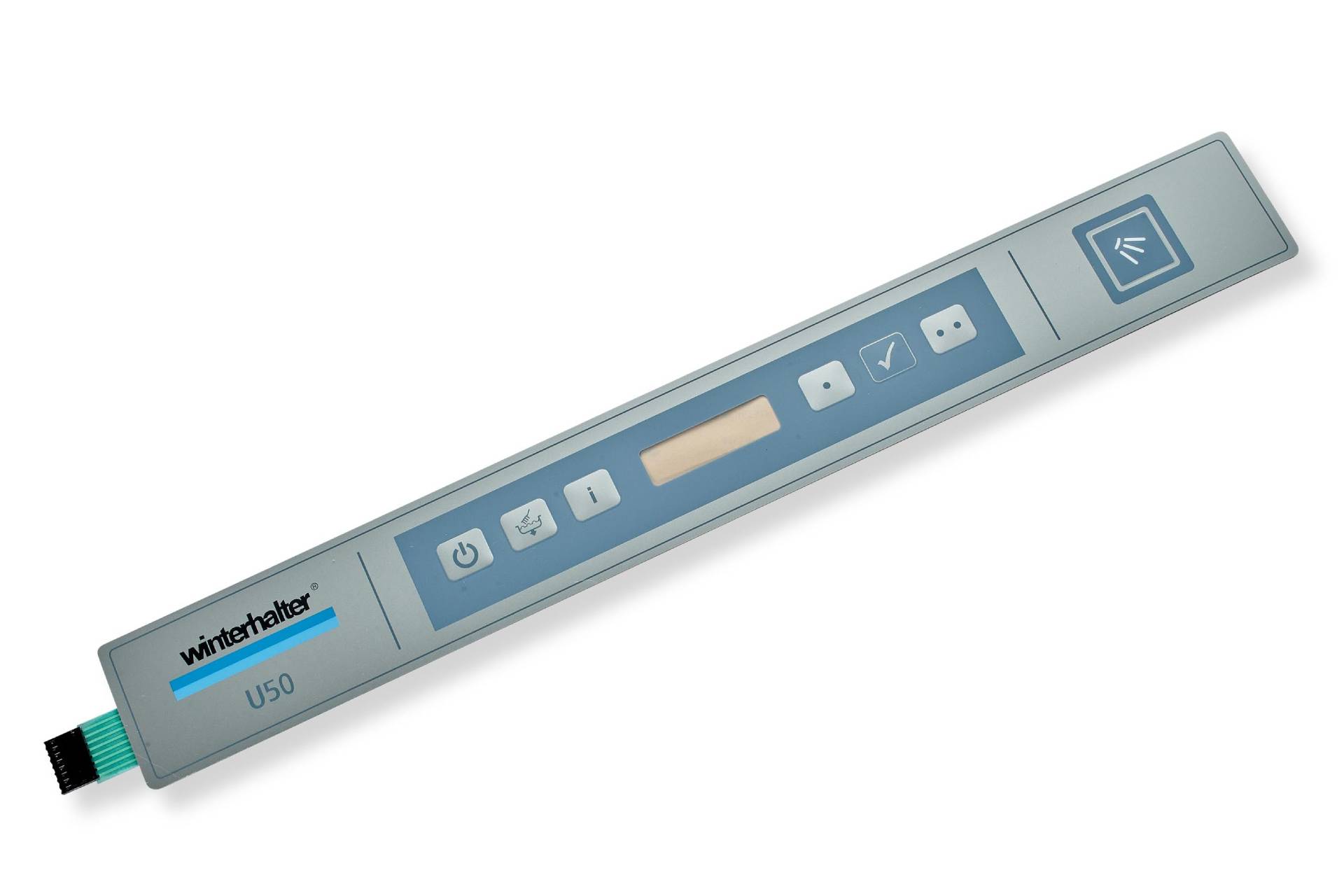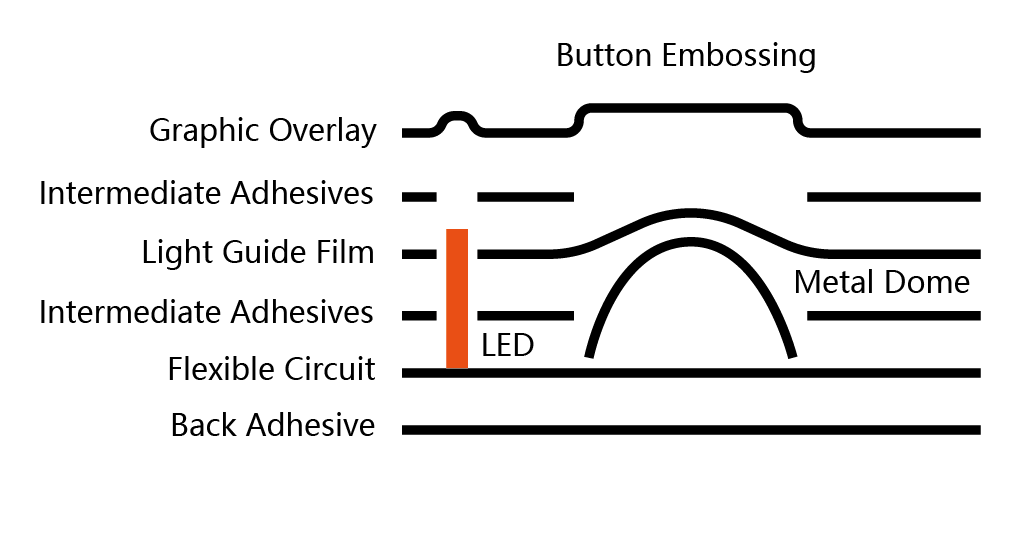The role of membrane switch in next-gen consumer appliances
Everything About Membrane layer Change: A Comprehensive Guide for Beginners
Membrane switches are vital components in modern-day electronics, offering an one-of-a-kind interface for user interaction - membrane switch. Their split building, consisting of overlays and conductive traces, supplies functionality and durability. Unlike standard mechanical switches, membrane buttons present a smooth design and adjustable alternatives. Comprehending their vital functions and advantages can transform product layout. The intricacies of their application and design factors to consider necessitate more exploration.
What Is a Membrane layer Switch over?
A membrane switch is a kind of electric switch that consists of a versatile membrane layered over a printed circuit card. This layout permits a streamlined and small interface, commonly made use of in various electronic gadgets. Membrane layer buttons are generally found in customer appliances, medical tools, and commercial equipment due to their toughness and resistance to environmental factors.The building and construction usually includes several layers, such as graphic overlays and glue support, which give tactile responses and shield the circuitry beneath. The operation of a membrane layer switch is started when pressure is related to the surface area, finishing an electrical circuit.These switches are valued for their versatility, enabling custom-made styles and published graphics that satisfy certain customer interfaces. Their inconspicuous nature reduces area needs, making them excellent for applications where conventional switches may not fit. In general, membrane buttons supply a practical and visual option for modern digital tools.
Key Parts of Membrane Layer Switches Over
Membrane changes consist of numerous crucial elements that add to their performance and performance. The top layer, referred to as the overlay, offers the interface and is frequently published with icons or graphics. Beneath the overlay lies a spacer layer, which divides the conductive components and stops unintended activation. The next vital element is the visuals layer, which enhances aesthetic appeals and assures the resilience of the design.Conductive traces, usually made from products like silver or carbon, are printed on the circuit layer. When stress is related to the overlay, these traces enter into contact, finishing the circuit. Furthermore, a support layer provides architectural assistance and can be made from materials such as polyester or polycarbonate. Together, these elements create a trusted, straightforward interface appropriate for various applications, from family appliances to commercial devices. Comprehending these elements is crucial for anyone thinking about membrane layer button modern technology.
Just How Membrane Layer Changes Work
Recognizing how membrane switches over feature is necessary for valuing their extensive usage in numerous gadgets. A membrane switch operates through a collection of layers, including a graphic overlay, spacer, and a circuit layer. When pressure is put on the overlay, it presses the spacer layer, enabling the circuit layer to make call and complete an electrical circuit. This activity sends a signal to the tool, triggering a reaction, such as switching on a light or activating a function.Membrane changes can be made with different functions, including tactile comments, backlighting, and custom graphics, boosting user interaction. Their building and construction enables a closed style, protecting the interior parts from dirt, moisture, and pollutants. This longevity makes them suitable for diverse applications, from customer electronics to commercial devices. On the whole, the simplicity and efficiency of membrane layer changes add to their appeal in modern-day technology.
Benefits of Membrane Layer Switches Mechanical Buttons
While mechanical switches have actually long been a staple in many tools, membrane layer switches deal distinct advantages that make them significantly appealing. One considerable advantage is their slim account, permitting more small layouts and higher versatility in item advancement. Furthermore, membrane layer switches over function a consistent surface area, which improves visual allure and streamlines cleansing, making them appropriate for environments where hygiene is critical.Another benefit is their resistance to dirt and moisture. Unlike mechanical buttons, which can be endangered by environmental elements, membrane layer switches provide a covered user interface that secures against pollutants - membrane switch. Moreover, membrane layer switches generally have a longer life expectancy because of less moving components, resulting in improved longevity and reliability.Cost-effectiveness is also a noteworthy benefit, as membrane buttons can be produced wholesale with lower production prices. These variables combine to place membrane switches as a functional option to typical mechanical choices in numerous applications
Typical Applications of Membrane Switches Over
Membrane switches are commonly utilized in various industries, specifically in customer electronic devices and industrial control board. In consumer devices, they give a sleek, easy to use interface, while in commercial setups, they improve resilience and functionality. Recognizing these applications highlights the adaptability and practicality of membrane switches in contemporary technology.
Customer Electronics Instruments
As consumer electronic devices proceed to advance, membrane layer buttons have actually ended up being a preferred option for a range of devices as a result of their versatility and sleek layout. These switches are typically located in smartphones, tablets, and remotes, where room is limited and aesthetic appeals matter. Their low account and customizable styles permit makers to produce straightforward user interfaces that improve the general individual experience. Furthermore, membrane buttons are typically utilized in home appliances such as microwaves and coffee manufacturers, providing user-friendly control alternatives while resisting wetness and dust. The resilience and reliability of membrane layer switches make them suitable for everyday consumer items, making certain longevity and consistent efficiency. Overall, their assimilation in consumer electronic devices mirrors a blend of functionality and modern-day layout.
Industrial Control Panels
The applications of membrane layer switches extend beyond consumer electronics, discovering substantial use in commercial control panels. These switches are preferred for their longevity and resistance to severe atmospheres, making them optimal for producing and procedure control settings. They give a trustworthy interface for drivers to manage machinery, screen processes, and adjust setups. Membrane layer buttons can be personalized to match specific operational requirements, incorporating functions like backlighting and tactile comments, improving user experience. Their inconspicuous layout permits assimilation right into different devices, while their capability to stand up to spills, dust, and extreme temperature levels assurances durability. On the whole, membrane layer switches add to reliable and risk-free procedure in commercial applications, demonstrating their adaptability and effectiveness sought after environments.
Considerations for Designing Membrane Layer Switches
When creating membrane layer buttons, selecting the appropriate materials is necessary to assure durability and performance. In addition, comprehending layer arrangement methods can greatly impact the switch's efficiency and individual experience. These considerations play a vital role in creating efficient and Visit Website dependable membrane switch styles.
Product Choice Significance
Material choice plays a vital duty in the style and performance of membrane layer buttons. The selected materials directly affect the button's durability, tactile reaction, and overall visual. Trick factors to consider consist of the substrate, which should give structural integrity while permitting versatility, and the graphic overlay, which requires to be immune to use and environmental elements. Conductive materials must assure trusted electric efficiency, while adhesives need to provide strong bonding without endangering the button's procedure. In addition, compatibility with producing processes and end-user settings is crucial; materials should endure varying temperature levels, humidity degrees, and chemical direct exposure. Extra resources Eventually, appropriate product choice not just improves the membrane layer button's performance however also adds to its durability and user satisfaction, making it a vital element of the design procedure.

Layer Configuration Techniques

Frequently Asked Inquiries
Exactly How Long Do Membrane Switches Over Normally Last?
Membrane buttons normally have a lifespan of 1 to 5 million cycles, depending upon usage and environmental problems. Factors such as style top quality and operating frequency considerably affect their resilience and total performance longevity.

Can Membrane Changes Be Custom-made for Particular Designs?
Membrane switches can indeed be tailored to fit details layouts, enabling for diverse shapes, colors, and functionalities. This versatility allows manufacturers to customize these buttons to satisfy one-of-a-kind visual and operational requirements effectively.
What Materials Are Utilized in Membrane Switch Over Construction?
Membrane layer switches are usually created making use of products such as polyester, polycarbonate, and glue layers. These materials provide resistance, sturdiness, and adaptability to environmental factors, making sure the buttons work efficiently in different applications and problems.
Are Membrane Changes Waterproof or Resistant to Wetness?
Membrane buttons can be made to be moisture-resistant, making use of specialized materials and finishings. Their water-proof capacities depend on construction quality and particular applications, making it necessary to examine needs for optimal performance in numerous environments.
How Are Membrane Layer Switches Over Fixed if Harmed?
Repairing damaged membrane layer switches over generally includes replacing the affected layer or circuit. Specialists might likewise use conductive adhesive or use specialized repair sets, making certain functionality is brought back without complete replacement of the whole switch setting up. Unlike conventional mechanical switches, membrane buttons offer a sleek style and personalized alternatives. A membrane layer switch is a type of electrical switch that consists of a flexible membrane layered over a printed circuit board. The operation of a membrane switch navigate to this site is started when pressure is used to the surface, completing an electric circuit.These switches are valued for their flexibility, enabling custom-made layouts and printed graphics that cater to particular customer interfaces. While mechanical switches have long been a staple in lots of gadgets, membrane switches offer distinctive advantages that make them progressively appealing. Membrane layer switches usually have a longer lifespan due to less relocating components, resulting in improved sturdiness and reliability.Cost-effectiveness is also a remarkable advantage, as membrane switches can be produced in mass with lower production costs.